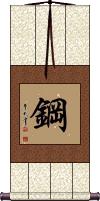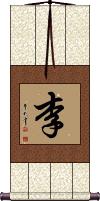Many custom options...
And formats...

Mr in Chinese / Japanese...
Buy a Mr calligraphy wall scroll here!
Personalize your custom “Mr” project by clicking the button next to your favorite “Mr” title below...
The Whole Room Rocks With Laughter
The perfect scroll if you love humor or as a gift for the comedian in your life
In China, 哄堂大笑 is a proverb that is used in response to a good joke or witty comment.
The story goes that Mr. Feng and Mr. He were both senior officials in the Song Dynasty (about a thousand years ago). One day, Mr. Feng walked into their shared office wearing a new pair of boots. The boots caught the eye of Mr. He who said, “New boots! - how much were they?.” Mr. Feng lifted one of the boots off the ground as if to show it off and responded, “900 coins.”
Astonished, Mr. Feng explained, “900? How can that be? - I paid 1800 coins for my boots!.” Mr. Feng then lifted his other foot off the ground and said, “This boot was also 900 coins.”
It is said that the whole room was shaking from the laughter of all that heard Mr. Feng's joke on Mr. He.
Steel
鋼 is the Chinese character and Japanese Kanji for steel (as in iron mixed with carbon and other elements to make it stronger).
This can also be the name Hagane in Japanese. Like Mr. Steel in English. It can also be pronounced as Tsuyoshi or Kou when used as a personal or given name in Japan.
50th Golden Wedding Anniversary
幸福金婚 means “Happy Golden Anniversary” and is a great gift for a couple who is celebrating 50 years together.
The first two characters mean happy, blessed, or happiness.
The last two characters mean “couple's golden anniversary.” It means “golden wedding” or “golden marriage,” but this is only used for the 50-year-mark of a marriage (the same way we use gold to represent 50 years in the west).
幸福金婚 is a nice title to use with an inscription. You could request something like, “Happy 50th Anniversary, Mr. and Mrs. Smith,” to be written down the side of this title in smaller Chinese characters.
Please note: This can be pronounced and understood in Japanese but not as commonly used in Japan. Japanese people who read this will understand it but might tend to feel it’s of Chinese origin.
Lee / Plum
This is the most common Chinese character which sounds like “Lee” or “Li” and is used as a surname / family name in China.
李 actually means “Plum.” So it's really Mr. Plum and Mrs. Plum if you translated the name instead of romanizing.
This is not the only character in Chinese that can be romanized as “Lee” or “Li.” If your family name is “Lee” or “Li” please be sure this is the correct character before you order this scroll (look at your grandparents' Chinese passports or other documents if you are an ABC and are trying to create a heritage wall scroll).
Famous people with this surname include Bruce Lee (Li Xiao-Long), Minister Li Peng, and famous Tang Dynasty poet Li Bai.
In Korea, this is the original character for a surname that romanizes as “Yi.”
Note: This also one version of Lee that is a common Korean surname. However, it’s often romanized as "Yi" and sometimes as "Ri" or "Rhee."
Not the results for mr that you were looking for?
Below are some entries from our dictionary that may match your mr search...
| Characters If shown, 2nd row is Simp. Chinese |
Pronunciation Romanization |
Simple Dictionary Definition |
君 see styles |
jun jun1 chün kun くん |
More info & calligraphy: June(suffix) (1) (after the name of a male of equal or lower status) Mr; master; boy; (suffix) (2) (after the name of a female of lower status; used by males in formal settings) Ms; miss; (suffix) (3) (archaism) (still used among members of the Japanese Diet) sir; madam; (personal name) Kunji Prince, noble, ideal man or woman; translit. kun. |
先生 see styles |
xiān sheng xian1 sheng5 hsien sheng shiisan / shisan シーサン |
More info & calligraphy: Sensei / Master / Teacher / Mister(honorific or respectful language) (rare) man (chi: xiānshēng); boy; (surname) Senjō Senior, sir, teacher, master, Mr.; a previous life. |
殿 see styles |
diàn dian4 tien dono どの |
palace hall (suffix) (polite language) (form of address used for official letters and business letters, and in letters to inferiors) Mr.; Mrs.; Miss; Ms.; (surname) Tonosaki A temple, hall, palace; rearguard. |
氏 see styles |
zhī zhi1 chih shi し |
used in 月氏[Yue4zhi1]; used in 閼氏|阏氏[yan1zhi1] (suffix) (1) (honorific or respectful language) Mr; Mrs; Ms; Miss; (n,suf) (2) clan; (pronoun) (3) (honorific or respectful language) he; him; (counter) (4) (honorific or respectful language) counter for people; (surname) Hamauji |
MR see styles |
emu aaru; emuaaru(sk) / emu aru; emuaru(sk) エム・アール; エムアール(sk) |
(1) medical representative; pharmaceutical sales representative; (2) (See ミクストリアリティー) mixed reality; MR; (3) (See マーケティングリサーチ) marketing research; (4) {med} (See 僧帽弁閉鎖不全) mitral regurgitation |
何某 see styles |
nanibou / nanibo なにぼう nanigashi なにがし |
(pn,adj-no) (1) (kana only) certain person; certain amount; Mr So-and-so; (2) (kana only) I (personal pronoun) |
呂覽 吕览 see styles |
lǚ lǎn lu:3 lan3 lü lan |
"Mr Lü's Annals", same as 呂氏春秋|吕氏春秋[Lu:3 shi4 Chun1 qiu1] |
左傳 左传 see styles |
zuǒ zhuàn zuo3 zhuan4 tso chuan saden さでん |
Zuo Zhuan or Tsochuan, Mr Zuo's Annals or Mr Zuo's commentary on 春秋[Chun1 qiu1], early history c. 400 BC attributed to famous blind historian Zuo Qiuming 左丘明[Zuo3 Qiu1 ming2] (surname) Saden Zuo's Commentary |
座下 see styles |
zaka ざか |
(1) nearby (one's seat); (by) one's side; (2) (used in letters after the name of the recipient) Dear (Mr.-Mrs.) |
懂哥 see styles |
dǒng gē dong3 ge1 tung ko |
(slang) Mr. Know-it-all |
某氏 see styles |
boushi / boshi ぼうし |
a certain person; unnamed person; Mr. So-and-so; a certain someone who shall remain unnamed |
法公 see styles |
fǎ gōng fa3 gong1 fa kung hōkō |
Signior of the Law, a courtesy title of any monk. |
男神 see styles |
nán shén nan2 shen2 nan shen ogami おがみ |
Mr Perfect; Adonis; Prince Charming male god; male deity; (place-name, surname) Ogami |
誰某 see styles |
daresore だれそれ |
(pn,adj-no) a certain someone; Mr So-and-so |
きゅん see styles |
kyun きゅん |
(suffix) (colloquialism) (See くん・1) Mr; master; boy; (personal name) Kuen |
ちゃま see styles |
chama ちゃま |
(suffix) (honorific or respectful language) (familiar language) (child. language) (after a person's name, position, etc.) (See 様・さま・1) Mr.; Mrs.; Miss |
公羊傳 公羊传 see styles |
gōng yáng zhuàn gong1 yang2 zhuan4 kung yang chuan |
Mr Gongyang's Annals or commentary on 春秋[Chun1 qiu1], early history, probably written by multiple authors during Han dynasty, same as 公羊春秋[Gong1 yang2 Chun1 qiu1] |
十三經 十三经 see styles |
shí sān jīng shi2 san1 jing1 shih san ching |
the Thirteen Confucian Classics, namely: Book of Songs 詩經|诗经[Shi1 jing1], Book of History 尚書|尚书[Shang4 shu1], Rites of Zhou 周禮|周礼[Zhou1 li3], Rites and Ceremonies 儀禮|仪礼[Yi2 li3], Classic of Rites 禮記|礼记[Li3 ji4], Book of Changes 易經|易经[Yi4 jing1], Mr Zuo's Annals 左傳|左传[Zuo3 Zhuan4], Mr Gongyang's Annals 公羊傳|公羊传[Gong1 yang2 Zhuan4], Mr Guliang's Annals 穀梁傳|谷梁传[Gu3 liang2 Zhuan4], The Analects 論語|论语[Lun2 yu3], Erya 爾雅|尔雅[Er3 ya3], Classic of Filial Piety 孝經|孝经[Xiao4 jing1], Mencius 孟子[Meng4 zi3] |
德先生 see styles |
dé xiān sheng de2 xian1 sheng5 te hsien sheng |
"Mr Democracy", phrase used during the May 4th Movement 五四運動|五四运动[Wu3 si4 Yun4 dong4]; abbr. for 德謨克拉西|德谟克拉西[de2 mo2 ke4 la1 xi1]; see also 賽先生|赛先生[Sai4 xian1 sheng5] |
誰それ see styles |
daresore だれそれ |
(pn,adj-no) a certain someone; Mr So-and-so |
賽先生 赛先生 see styles |
sài xiān sheng sai4 xian1 sheng5 sai hsien sheng |
"Mr Science", phrase used during the May 4th Movement 五四運動|五四运动[Wu3 si4 Yun4 dong4]; abbr. for 賽因斯|赛因斯[sai4 yin1 si1]; see also 德先生[De2 xian1 sheng5] |
那個人 那个人 see styles |
nà gè rén na4 ge4 ren2 na ko jen |
lit. that person; fig. the person you have been looking for; Mr Right; the girl of one's dreams |
革蘭氏 革兰氏 see styles |
gé lán shì ge2 lan2 shi4 ko lan shih |
Mr Gram; Dr. Hans Christian Jaochim Gram (1953-1938), Danish doctor and inventor of the Gram stain 革蘭氏染色法|革兰氏染色法 |
高富帥 高富帅 see styles |
gāo fù shuài gao1 fu4 shuai4 kao fu shuai |
"Mr Perfect" (i.e. tall, rich and handsome) (Internet slang) |
ミスター see styles |
misutaa / misuta ミスター |
mister; Mr |
ミスチル see styles |
misuchiru ミスチル |
(group) Mr. Children (Japanese band) (abbreviation) |
何とやら see styles |
nantoyara なんとやら |
(adverb) (1) for some reason or other; somehow; (expression) (2) whatsitsname; what-you-call-it; Mr. so-and-so; (expression) (3) and so on; and you know the rest |
公羊春秋 see styles |
gōng yáng chūn qiū gong1 yang2 chun1 qiu1 kung yang ch`un ch`iu kung yang chun chiu |
Mr Gongyang's Annals or commentary on 春秋[Chun1 qiu1], early history, probably written during Han dynasty, same as 公羊傳|公羊传[Gong1 yang2 Zhuan4] |
呂氏春秋 吕氏春秋 see styles |
lǚ shì chūn qiū lu:3 shi4 chun1 qiu1 lü shih ch`un ch`iu lü shih chun chiu |
lit. “Mr. Lü's Spring and Autumn (Annals)”, compendium of the philosophies of the Hundred Schools of Thought 諸子百家|诸子百家[zhu1 zi3 bai3 jia1], compiled around 239 BC under the patronage of Qin Dynasty 秦代[Qin2 dai4] Chancellor Lü Buwei 呂不韋|吕不韦[Lu:3 Bu4 wei2] |
太郎さん see styles |
tarousan / tarosan たろうさん |
(1) (slang) (used by restaurant staff) cockroach; (2) Mr Tarou |
Click here for more mr results from our dictionary
The following table may be helpful for those studying Chinese or Japanese...
| Title | Characters | Romaji (Romanized Japanese) | Various forms of Romanized Chinese | |
| The Whole Room Rocks With Laughter | 哄堂大笑 | hōng tāng dà xiào hong1 tang1 da4 xiao4 hong tang da xiao hongtangdaxiao | hung t`ang ta hsiao hungtangtahsiao hung tang ta hsiao |
|
| Steel | 鋼 钢 | hagane | gāng / gang1 / gang | kang |
| 50th Golden Wedding Anniversary | 幸福金婚 / 倖福金婚 幸福金婚 | kou fuku kin kon koufukukinkon ko fuku kin kon | xìng fú jīn hūn xing4 fu2 jin1 hun1 xing fu jin hun xingfujinhun | hsing fu chin hun hsingfuchinhun |
| Lee Plum | 李 | ri / sumomo | lǐ / li3 / li | |
| In some entries above you will see that characters have different versions above and below a line. In these cases, the characters above the line are Traditional Chinese, while the ones below are Simplified Chinese. | ||||
Successful Chinese Character and Japanese Kanji calligraphy searches within the last few hours...







